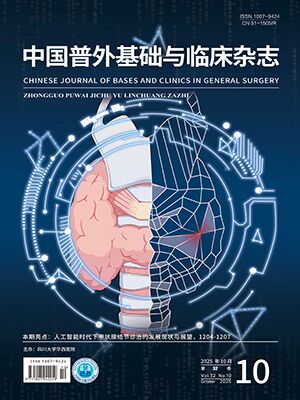| 1. |
陈伟玲, 张国君. 乳腺癌新辅助治疗中外指南对比解读. 中国肿瘤外科杂志, 2023, 15(3): 219-224.
|
| 2. |
Korde LA, Somerfield MR, Carey LA, et al. Neoadjuvant chemotherapy, endocrine therapy, and targeted therapy for breast cancer: ASCO guideline. J Clin Oncol, 2021, 39(13): 1485-1505.
|
| 3. |
Tjan-Heijnen V, Viale G. The lymph node and the metastasis. N Engl J Med, 2018, 378(21): 2045-2046.
|
| 4. |
毕钊, 王永胜. 乳腺癌新辅助治疗策略与手术时机. 中国实用外科杂志, 2021, 41(11): 1220-1225.
|
| 5. |
Brackstone M, Baldassarre FG, Perera FE, et al. Management of the axilla in early-stage breast cancer: Ontario health (Cancer Care Ontario) and ASCO guideline. J Clin Oncol, 2021, 39(27): 3056-3082.
|
| 6. |
Zarifmahmoudi L, Aghaee A, Treglia G, et al. Sentinel lymph node mapping in breast cancer patients following neoadjuvant chemotherapy: systematic review and meta-analysis about head to head comparison of cN0 and cN+ patients. Breast Cancer, 2022, 29(1): 50-64.
|
| 7. |
Chen M, Kong C, Lin G, et al. Development and validation of convolutional neural network-based model to predict the risk of sentinel or non-sentinel lymph node metastasis in patients with breast cancer: a machine learning study. EClinicalMedicine, 2023, 63: 102176. doi: 10.1016/j.eclinm.2023.102176.
|
| 8. |
朱娅娣. 基于磁共振多参数影像组学术前预测乳腺癌前哨淋巴结转移的研究. 苏州: 苏州大学, 2024.
|
| 9. |
张雪丽, 王孟瑶, 杨志豪, 等. 人工智能在乳腺癌磁共振诊断中的研究进展. 磁共振成像, 2025, 16(3): 184-189.
|
| 10. |
Lin SQ, Vo NP, Yen YC, et al. Outcomes of sentinel node biopsy for women with breast cancer after neoadjuvant therapy: Systematic review and meta-analysis of real-world data. Ann Surg Oncol, 2022, 29(5): 3038-3049.
|
| 11. |
于理想, 余之刚. 乳腺癌新辅助治疗前哨淋巴结处理原则. 中国实用外科杂志, 2021, 41(11): 1230-1234.
|
| 12. |
Wang X, Wang X, Zhang Y, et al. Development of the prediction model based on clinical-imaging omics: molecular typing and sentinel lymph node metastasis of breast cancer. Ann Transl Med, 2022, 10(13): 749. doi: 10.21037/atm-22-2844.
|
| 13. |
Tan YY, Wu CT, Fan YG, et al. Primary tumor characteristics predict sentinel lymph node macrometastasis in breast cancer. Breast J, 2005, 11(5): 338-343.
|
| 14. |
Chen M, Palleschi S, Khoynezhad A, et al. Role of primary breast cancer characteristics in predicting positive sentinel lymph node biopsy results: a multivariate analysis. Arch Surg, 2002, 137(5): 606-609.
|
| 15. |
Yoshida A, Kojima Y, Tazo M, et al. Can sentinel node biopsy after neoadjuvant systemic chemotherapy (NAC) be safely omitted in selected patients with early breast cancer? J Clin Oncol, 2020, 38(15_suppl): 564. doi: 10.1200/JCO.2020.38.15_suppl.564.
|
| 16. |
Yuan J, Xiong J, Yang J, et al. Machine learning-based 28-day mortality prediction model for elderly neurocritically ill patients. Comput Methods Programs Biomed, 2025, 260: 108589. doi: 10.1016/j.cmpb.2025.108589.
|
| 17. |
Li L, Cui X, Yang J, et al. Using feature optimization and LightGBM algorithm to predict the clinical pregnancy outcomes after in vitro fertilization. Front Endocrinol (Lausanne), 2023, 14: 1305473. doi: 10.3389/fendo.2023.1305473.
|
| 18. |
Rakha EA, Martin S, Lee AH, et al. The prognostic significance of lymphovascular invasion in invasive breast carcinoma. Cancer, 2012, 118(15): 3670-3680.Rakha EA, Martin S, Lee AH, et al. The prognostic significance of lymphovascular invasion in invasive breast carcinoma. Cancer, 2012, 118(15): 3670-3680.
|
| 19. |
Edge SB, Compton CC. The American Joint Committee on cancer: the 7th edition of the AJCC cancer staging manual and the future of TNM. Ann Surg Oncol, 2010, 17(6): 1471-1474.Edge SB, Compton CC. The American Joint Committee on cancer: the 7th edition of the AJCC cancer staging manual and the future of TNM. Ann Surg Oncol, 2010, 17(6): 1471-1474.
|
| 20. |
Dong Y, Feng Q, Yang W, et al. Preoperative prediction of sentinel lymph node metastasis in breast cancer based on radiomics of T2-weighted fat-suppression and diffusion-weighted MRI. Eur Radiol, 2018, 28(2): 582-591.Dong Y, Feng Q, Yang W, et al. Preoperative prediction of sentinel lymph node metastasis in breast cancer based on radiomics of T2-weighted fat-suppression and diffusion-weighted MRI. Eur Radiol, 2018, 28(2): 582-591.
|
| 21. |
Wang L, Zhang K, Feng J, et al. The progress of platelets in breast cancer. Cancer Manag Res, 2023, 15: 811-821.
|
| 22. |
Zha HL, Zong M, Liu XP, et al. Preoperative ultrasound-based radiomics score can improve the accuracy of the Memorial Sloan Kettering Cancer Center nomogram for predicting sentinel lymph node metastasis in breast cancer. Eur J Radiol, 2021, 135: 109512. doi: 10.1016/j.ejrad.2020.109512.
|
| 23. |
江宁祥, 曹迪, 李振宇, 等. 肿瘤恶性增殖及侵袭相关基因在乳腺癌组织中表达水平与前哨淋巴结阳性数相关性分析. 中国医药, 2021, 16(8): 1236-1240.
|




